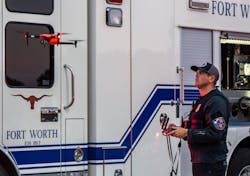Fire Tech Brief: 5 Things to Know Before Starting a Fire Department Drone Program
For a lot of departments, discussions of adding technology often leads to the low hanging fruit of adding a drone or starting an Unmanned Aerial System (UAS) program. While this is quickly growing beyond simple reconnaissance/search and rescue applications to the use of drones as responders, taking the time to rigorously evaluate your program before it ever launches is key to success. At a minimum, take a look and consider these five things you need to know before you start a drone program or purchase any equipment.
Why do you need a drone program?
Every good program begins with asking the simplest of questions…why? Departments that fail to ask this question and then ensure the answer is aligned with their mission, vision, and values often find themselves in unsustainable and costly situations, sometimes wasting taxpayer’s funding. When talking to the leading experts on the UAS Task Force for the International Association of Fire Chief’s Technology Council, they indicated that all to often a department has end-of-year money to spend and they will buy a drone. This leads to building a program around the equipment they bought instead of getting what they really needed.
Stopping to ask "why" will identify key elements that will guide the purchasing process and drone program development. Also, know that like all technical competencies you often must crawl before you walk or run. That means almost no fire department is going to go from no drone program to having drones deliver payloads such as life preservers or AEDs in quick order. If you know the end goal of where you want the program to be, you can often make smarter decisions on equipment platforms that, in many cases, have add-ons to increase operational capabilities.
Creating policies to guide
Public safety drones are not the toys you buy in a store and often there are serious considerations for use that need to be addressed prior to ever putting a drone in the air. Beyond being a significant investment, they also cross into federal regulations through the Federal Aviation Administration (FAA).
Departments need to consider who is authorized to place a drone in service, what conditions it will operate, what agencies it will assist (especially when crossing into law enforcement operations), and what mission it will serve.
Since most drones have the ability to capture and store images, video, and telemetric data, they enter the realm of public data. Policies governing the collection and use of data in addition to data retention and dissemination will help prevent a department from crossing legal lines that could prove to be extremely costly.
As a final consideration, it is also good to review the department’s insurance policies to ensure potential damage caused by a wayward drone is going to be covered. Public input on policies is also an effective way to engage with our residents to improve community acceptance of what is essentially a surveillance device.
Ultimately, good policies are also a foundation for safe operations. There are too many lessons learned related to a lack of policies, do not add to the list of departments that are under negative attention for what was supposed to be an innovative addition to the services provided to help the community.
Pilot standards
There are two paths to becoming a certified remote pilot. According to the FAA, there are first-time pilots and existing (Part 61 certificate holders). Eligibility for first-time pilots includes:
- Must be at least 16 years old (important if you have Explorers)
- Be able to read, speak, write, and understand English
- Be in a physical and mental condition to safely fly a drone
- Pass the initial aeronautical knowledge exam (Unmanned Aircraft General – Small)
- Eligibility for existing pilots includes:
- Must hold a pilot certificate issued under 14 CFR Part 61
- Must have completed a flight review within the previous 24 months
For complete details check these details on how to become a certificated remote pilot. Just like when hunting or fishing in most states, you better make sure the UAS pilot has their remote pilot certificate available while flying.
Training beyond Part 107
Throughout my career I hated the ideal of minimum training standards, which is essentially one step up from incompetence. When it comes to operating a public safety drone, there are often high-stress and high-risk incidents that require the pilot to be well beyond the minimum training standards. At a minimum completing a “Part 107 training course” is the initial training to get a pilot to the starting line of being able to operate a drone.
Depending on the mission scope, there are a growing number of strategies and tactic courses that will help a pilot identify best practices, common approaches, and safety considerations for each incident type. Additionally, after seven years of arduous work and lobbying there are finally courses at the National Fire Academy with the first offering currently accepting enrollment until July 7, 2025. NFA A-450 (Basic Remote Pilot) and NFA S-373 (Incident Operations) are groundbreaking train-the-trainer programs meant to exponentially expand the ability to provide this training for future pilots. Contact Jeff Pricher or Logan Davis for more information, or apply with this form.
Annual & ongoing expenses
As an often end of year surplus expense, departments often fail to research the annual and ongoing expenses of a drone program. Beyond general maintenance considerations, which should always be considered with every fire department equipment purchase, there are increasing demands for maintaining FAA records, storing video footage (server space), the potential need for specialized software to track flight logs/hours, and streaming software subscriptions. This is on top of annual training requirements for pilots, repairs to the equipment from potential mishaps, increases in department insurance costs, and add-ons to the aerial platform to expand capabilities.
Conclusion
After reading this article, some of you may be second guessing your decision to pursue a drone program. However, like other areas of the fire service, this is not a journey you need to complete on your own. There are links throughout the article for resources that are more than willing to help you succeed and there are several departments that have a robotics group or division due to the value that drones add to the department.
If anything, I hope reviewing these five things to know before starting a drone program encourages you to build it properly so it can benefit your community for years to come.
About the Author

Jason Moore
Jason Moore is a 23-year veteran of the fire service who began his career with the U.S. Air Force as a fire protection specialist. Moore is involved with the International Association of Fire Chiefs’ Technology Council and is a founding member/associate director of the Indiana University Crisis Technologies Innovation Lab. He delivered presentations on implementing technology, using technology for community risk reduction and best practices to justify funding for innovative programs. Moore was the keynote speaker at FireFusion 2024 and is a member of the Firehouse Editorial Advisory Board.
